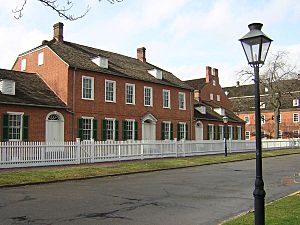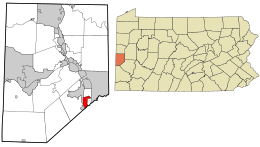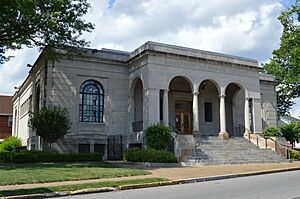Ambridge, Pennsylvania facts for kids
Quick facts for kids
Ambridge, Pennsylvania
|
|
|---|---|

The Rapp House in Old Economy Village
|
|
| Motto(s):
Proud Past, Bright Future
|
|

Location in Beaver County and the U.S. state of Pennsylvania.
|
|
| Country | United States |
| State | Pennsylvania |
| County | Beaver |
| Settled | 1824 |
| Incorporated | 1905 |
| Government | |
| • Type | Borough Council |
| Area | |
| • Total | 1.70 sq mi (4.41 km2) |
| • Land | 1.49 sq mi (3.85 km2) |
| • Water | 0.21 sq mi (0.55 km2) |
| Elevation | 764 ft (233 m) |
| Population
(2020)
|
|
| • Total | 6,972 |
| • Density | 4,688.63/sq mi (1,810.01/km2) |
| Time zone | UTC-5 (Eastern (EST)) |
| • Summer (DST) | UTC-4 (EDT) |
| Zip code |
15003
|
| Area code(s) | 724 |
| FIPS code | 42-02288 |
| Website | Borough of Ambridge |
Ambridge is a small town, called a borough, in Beaver County, Pennsylvania. It was officially created in 1905. Ambridge was built as a "company town" by the American Bridge Company. This means the company owned most of the land and housing. The town is about 16 miles (25 km) northwest of Pittsburgh, right next to the Ohio River. In 2020, about 6,972 people lived there.
Contents
History of Ambridge
Ambridge is located near a historic spot called Legionville. This was a training camp for General "Mad" Anthony Wayne's army in the late 1700s. It was the first place in the U.S. set up just for training soldiers.
The first people to settle here were a group called the Harmony Society. They started a village named "Ökonomie" (or Economy) in 1824. They were very successful and owned a lot of land. But over time, their group became smaller. By the late 1800s, only a few Harmonists were left.
The Harmony Society eventually sold their land. Much of it was bought by the American Bridge Company. This company then made the town bigger and officially named it Ambridge in 1905.
The American Bridge Company brought many immigrants to Ambridge. These people came from all over the world, hoping for work, freedom, and a peaceful life. The steel mills became the most important part of the town. Many workers were related, and the town grew quickly. Different parts of town became home to specific ethnic groups. Many groups had their own churches, clubs, and music groups. This helped them keep their culture alive. People came from places like Italy, Greece, Slovakia, Croatia, Ukraine, Poland, and Slovenia.
Ambridge became famous worldwide for making steel. The town was known for building bridges, shaping metal, and making large iron pipes. During World War II, the American Bridge Company made steel for building LSTs (Landing Ship Tanks). These were special ships used to land troops and vehicles during the war. The steel was then sent to a nearby shipyard where the LSTs were built. Other steel companies also operated in the area.
Over time, steel companies in other countries began to make more steel. This made it harder for U.S. companies to compete. The American Bridge Company in Ambridge closed in 1983. However, the bridges they built can still be seen all over the world.
Today, Ambridge is over 100 years old. The town is working to bring new life to its downtown area. Old buildings are being fixed up. New shops, like antique stores, are opening. An old industrial area is even being turned into homes, shops, and parks. In 2007, Ambridge was recognized as a "Preserve America Community." This means it's a place that works to protect its history. Ambridge hopes its location near Pittsburgh and the Ohio River will help it grow.
Geography
Ambridge is located at 40°35′35″N 80°13′31″W / 40.59306°N 80.22528°W. It sits right along the Ohio River.
The town covers about 1.7 square miles (4.4 square kilometers). Most of this area is land, but about 0.2 square miles (0.5 square kilometers) is water.
Nearby Areas
Ambridge shares its borders with two places on land. To the north, east, and northeast is Harmony Township. To the southwest is Leetsdale, which is in Allegheny County. The city of Aliquippa is across the Ohio River to the west. A bridge connects Ambridge to Aliquippa.
Population Information
| Historical population | |||
|---|---|---|---|
| Census | Pop. | %± | |
| 1910 | 5,205 | — | |
| 1920 | 12,730 | 144.6% | |
| 1930 | 20,227 | 58.9% | |
| 1940 | 18,968 | −6.2% | |
| 1950 | 16,429 | −13.4% | |
| 1960 | 13,865 | −15.6% | |
| 1970 | 11,324 | −18.3% | |
| 1980 | 9,575 | −15.4% | |
| 1990 | 8,133 | −15.1% | |
| 2000 | 7,769 | −4.5% | |
| 2010 | 7,050 | −9.3% | |
| 2020 | 6,972 | −1.1% | |
| 2021 (est.) | 6,869 | −2.6% | |
| Sources: | |||
In 2000, there were 7,769 people living in Ambridge. The town has a mix of different backgrounds. Most residents were White, and about 11% were African American. People from other racial groups also live there.
Arts and Culture
Even though different groups have lived in Ambridge for a long time, the town still celebrates its diverse roots. Since 1966, Ambridge has held an annual "Nationality Days" festival. This festival celebrates the town's different cultures. It brings people together with food, music, and fun.
The festival happens in May and lasts for three days. It takes place on Merchant Street in the downtown area. Many food vendors set up booths, offering delicious dishes from Italy, Ukraine, Greece, Poland, Germany, Croatia, and Slovenia. Local churches often sponsor these booths, sharing their traditional recipes like pierogi and stuffed cabbage. There is also live music, arts and crafts, and activities for kids. Thousands of people visit this festival every day.
Old Economy Village
Ambridge is home to Old Economy Village, a very important historical site. It is managed by the Pennsylvania Historical and Museum Commission. This site teaches visitors about the Harmony Society. They were a successful Christian communal society in the 1800s.
Old Economy Village was the third and final home for the Harmonists. It was founded in 1824 by George Rapp. The Harmonists were known for their strong Christian beliefs. They also became famous for making wool, cotton, and silk. In the 1830s and 1840s, Economy was known as a leader in the American silk industry.
Today, you can visit seventeen buildings and gardens that have been carefully restored. These were built between 1824 and 1830. The buildings show the unique way the Harmonists lived. They were known for their successful textile production. The site also shows how the community was involved in farming, railroads, and oil. The beautiful gardens cover more than 2 acres (8,000 square meters). They have colorful 19th-century flowers, stone paths, and a lovely stone pavilion. Old Economy Village helps people learn about this special community's history.
Education
Ambridge has its own public school system, called the Ambridge Area School District. It has five schools:
- Economy Elementary School (grades PK–5)
- Highland Elementary School (grades PK–5)
- State Street Elementary School (grades PK–5)
- Ambridge Area Junior High School (grades 6–8)
- Ambridge Area High School (grades 9–12)
High school students can also go to the Beaver County Career and Technology Center. There they can learn skills for jobs in construction and other trades.
Ambridge is also home to Trinity School for Ministry. This is a special school for people studying to become religious leaders in the Anglican church.
Notable people
- Richard D. Adams, U.S. Navy Admiral
- Peter A. Angeles, philosopher and writer
- George C. Axtell, U.S. Marine Corps general and World War II pilot
- Greg Blum, soccer player
- Eric Burns, journalist
- Ralph Caplan, design consultant and writer
- Eugene Caputo, lawyer and politician
- D. F. Creighton, architect and engineer
- Ann B. Davis, actress (from The Brady Bunch)
- Jerry Dennerlein, American football player
- Bob Gaona, American football player
- Marita Grabiak, television director
- Don Granitz, Christian missionary and football player/coach
- Robert K. Hamilton, former Speaker of the Pennsylvania House of Representatives
- Paul Hertneky, journalist and author
- George Kisiday, American football player
- Fred Klages, baseball pitcher
- Bill Koman, American football player
- Charles P. Laughlin, politician
- Mike Lucci, American football player
- Mickey Marotti, American football coach
- Robert Matzie, politician
- Elise Mercur, architect
- John Michelosen, American football player and coach
- Chuck Mrazovich, basketball player
- Leo Nobile, American football player
- George Rapp, founder of the Harmony Society
- David D. Thompson, U.S. Space Force General
- Guy Travaglio, politician
- Harry Ulinski, American football player
- Felisa Vanoff, dancer and choreographer
- Dennis Wuycik, basketball player
- Thomas Yankello, boxing trainer
- David Zubik, bishop of the Roman Catholic Diocese of Pittsburgh
See also
 In Spanish: Ambridge para niños
In Spanish: Ambridge para niños



